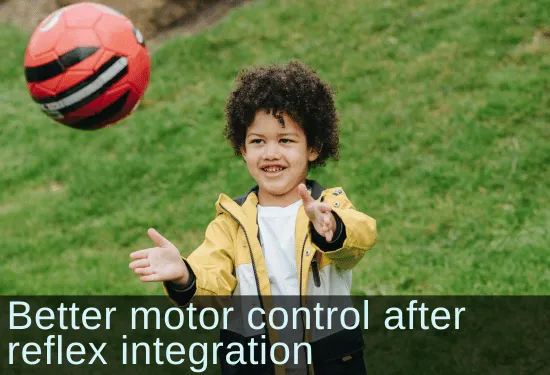Primitive Reflex Integration Case Studies
5-Year-Old Meets Balance and Coordination Goals in 2.5 Months
Occupational therapist uses rhythmic movements and reflex integration to help client in many areas
This preschooler exhibited a variety of sensory and gross motor issues. With just 10 sessions of rhythmic movements and reflex integration from the Brain and Sensory Foundations course, he greatly improved his visual tracking and met his goals for balance and coordination. He was also calmer and sleeping better.
Submitted by Submitted by S.G., MS, OTR/L
School District Occupational Therapist

| Before | After |
|---|---|
| Delay in upper limb coordination, bilateral coordination, and balance | Has met his balance, upper limb coordination, and bilateral coordination goals |
| Difficulty crossing the midline | Able to cross midline easily |
| Difficulty with visual tracking horizontally with smooth pursuits | Able to catch a ball with good tracking |
| Sleep challenges | Better sleep |
| Clothing sensitivities | Starting to be able to wear winter clothing |
This client is 5-years-old and receiving outpatient care in a private clinic. Child had difficulty this year in pre-K according to parents and evaluation report completed by another OT. He struggles with sensory overstimulation, difficulty with clothing sensitivities, sounds and any activities that involve inversion. He did have frequent ear infections as a child and met all motor milestones on time according to the parent report. BOT-2 evaluation completed 3 months before seen by this therapist showed a delay in upper limb coordination, bilateral coordination and balance. On the Sensory Profile he showed a definite difference in touch and multisensory input; a probable difference in auditory and vestibular input; and typical performance in visual and oral sensory input. Child has difficulty when observed with visual tracking horizontally with smooth pursuits.
When the previous therapist assessed for reflex integration, the child presented with a positive Moro reflex, ATNR [Asymmetrical Tonic Neck Reflex], TLR [Tonic Labyrinthine Reflex] and Spinal Galant reflex. Previous therapist had trained parents on Wilbarger brushing protocol with joint compressions to be completed at home. Started with this case at the end of May through the end of July for 10 sessions, 1-hour sessions weekly. Mom or Dad were present at all sessions.
Started with the Brain Tune Up and rhythmic movements [from the Brain and Sensory Foundations course], trained parents on rhythmic movements throughout sessions with child preferring movements 1, 3, and 2b. He tolerated anywhere from 1-5 minutes throughout sessions in increasing length with head nodding noted to improve to rhythm throughout sessions. Noticed calming of body after rhythmic movements. Parent agreed to complete movements at bedtime routine and came back reporting that it helped with him sleeping better as time went on. Heart connection was modeled to parents and the mom was able to practice during sessions. Child enjoyed the playful activities for the TLR [from the Brain and Sensory Foundations course], with increasing control noted from week to week. TLR tested as integrated within 3 weeks, we moved onto the Moro reflex next. Isometric integration required moderate assistance at first and in a few weeks he was able to complete it independently. He showed increased control during the playful integration activities as well. The child engaged in 3-5 minutes of passive and active reflex integration activities in therapy sessions and at home as parents could recall to complete, maybe a couple of times a week. Started to work on ATNR as Moro was showing signs of being integrated quickly. ATNR presented with mild responses to stimulation. Completed several of the playful activities, which were very motivating. Moved towards more focus on rhythmic movements 3 and 4 during this stage; parents stated he preferred 1 and 2b at home during sleep time.
At this point in the treatment process, I moved towards the 5-Step Balance [from the Brain and Sensory Foundations course] for the goal of enjoying wearing a variety of summer and winter clothing. His mother and I helped him with his goal of wearing winter clothes. We included ATNR and the Spinal Galant (due to his tactile issues). He exhibited great motor control during steps requiring midline crossing. We then had the parent bring in various clothing items and were able to have him try them and state which felt comfortable and which did not (he preferred lighter sweatshirts with no hood) for tops, and non-jean type softer pants. After the 5-Step Balance, a plan was able to be made with parents on how to continue this gain of wearing more weather appropriate clothing.
After 10 sessions, the child has met his balance, upper limb coordination and bilateral coordination goals. He is able to cross midline easily and is able to catch a ball with good tracking. We are working on integrating the Spinal Galant, and tactile sensitivities have steadily improved. The child is also able to tolerate inversion on the therapy ball for hoop activities with no complaints. This client has helped me to learn how to work through the rhythmic movements and reflex integration activities one step at a time. I had not realized how the Spinal Galant may have influenced many of the children that I work with that have difficulties with clothing and that has been interesting to see growth in this area.
(Edited, emphasis added)
*Disclaimer: The activities in the Brain and Sensory Foundations curriculum make use of the natural processes of neuroplasticity and development that are innately wired in the design of human beings to promote maturity and function. These activities appear to calm, organize, and mature the neuro-sensory-motor systems just as we see in the healthy development of human infants. Individual results may vary, and we do not claim to offer a diagnosis or cure for any specific condition or disorder. The Brain and Sensory Foundations activities appear to improve overall functioning resulting in measurable improvements for a range of conditions as demonstrated in over 1800 case studies from participants.

